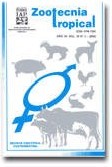
|
Zootecnia Tropical
Instituto Nacional de Investigaciones Agrícolas Venezuela
ISSN: 0798-7269
Vol. 28, No. 2, 2010, pp. 141-151
|
 Bioline Code: zt10016
Bioline Code: zt10016
Full paper language: English
Document type: Research Article
Document available free of charge
|
|
|
Zootecnia Tropical, Vol. 28, No. 2, 2010, pp. 141-151
| en |
Reproduction of Brahman females from two herds participating in a genetic improvement program
Gil, Manuel Guillermo Gómez; Quintero, Gilberto Antonio Pérez; Vásquez, Pedro Manuel Santéliz; Kocc, Aura Marina Cortés & Vilanova-Fernández, Lourdes Tibisay
Abstract
To evaluate Brahman female reproduction in two-herd population participating in a genetic improvement program
located in Cojedes and Portuguesa plains, heifer pregnancy (PN), pregnancy (PG) and Calving (PT) were studied.
For the analysis a logistic regression models with repeated measurement and maximum likelihood method was
carried out. Herd (H) and year of service season (A) were included as fixed effects for PN, and H, A and age at
service season (E) for PG and PT. Means for PN, PG and PT were 72,0%, 69,0% y 62,7%, respectively. A and H
were highly significant for all traits and E for PG and PT. A showed a wide range of variation of 55,6; 26,4 and
32,3 percentage points between worst and best year for PN, PG and PT, respectively. The herd located in Cojedes
had 32,4; 11,6 and 16,3 percentage points of superiority. The worst E was 3 years with 30,2 and 24,4 % of means,
while the best E were 8 and 9 years with 66.6 and 58,9 % for PG and PT, respectively. Results obtained in this
research showed that it is necessary to analyze information from multi-herds populations to characterize nongenetic
factors affecting the reproduction of Brahman females.
Keywords
Brahman, reproduction.
|
| |
| es |
Reproducción de hembras Brahman en dos rebaños pertenecientes a un programa de mejora genética
Gil, Manuel Guillermo Gómez; Quintero, Gilberto Antonio Pérez; Vásquez, Pedro Manuel Santéliz; Kocc, Aura Marina Cortés & Vilanova-Fernández, Lourdes Tibisay
Resumen
Con el objetivo de evaluar la reproducción de hembras Brahman de 2 rebaños ubicados en los llanos de Cojedes
y Portuguesa, pertenecientes a un programa de mejora genética conjunto, se estudiaron los caracteres preñez de
novillas (PN), preñez (PG) y parto (PT), con valores 1 (éxito) y 0 (fracaso). Para el análisis se aplicaron modelos
de regresión logística con medidas repetidas, usando el método de máxima verosimilitud. En PN se consideraron
los efectos fijos hato (H) y año de temporada de servicio (A), mientras que para PG y PT se añadió además, el
efecto edad en temporada de servicio (TS). Los promedios fueron 72,0% PN, 69,0% PG y 62,7% PT. A y H
resultaron altamente significativos sobre las 3 características y E sobre PG y PT. El A mostró una amplitud de
variación de 55,6, 26,4 y 32,3 puntos porcentuales entre el peor y mejor año para PN, PG y PT respectivamente.
El hato ubicado en Cojedes tuvo una superioridad de 32,4; 11,6 y 16,3 puntos porcentuales. Se encontró que
la peor E fue 3 años con valores de 30,2 y 24,4%, mientras que las mejores fueron 8 y 9 años con valores de
66,6 y 58,9% para PG y PT respectivamente. Los resultados de este trabajo demuestran la necesidad de analizar
información de poblaciones compuestas por varios rebaños que permitan caracterizar los factores no genéticos
que afectan la reproducción en hembras Brahman.
Palabras-clave
Brahman, reproducción
|
| |
© Copyright 2010 - Zootecnia Tropical
Alternative site location: http://www.sian.inia.gob.ve/repositorio/revistas_ci/ZootecniaTropical/ztindice.htm
|
|
